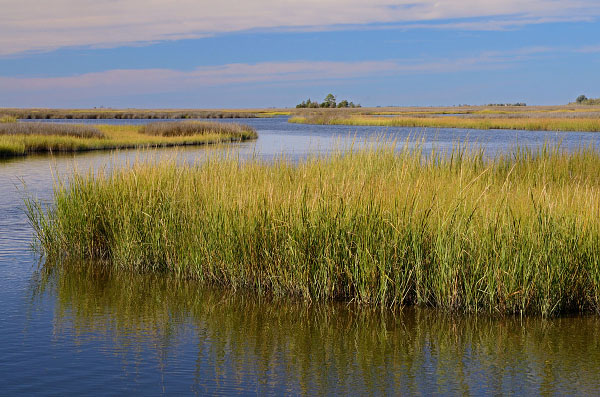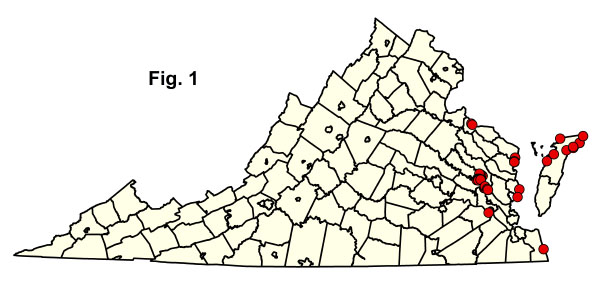

Virginia Department of Conservation and RecreationAn official website of the Commonwealth of Virginia Here's how you knowAn official websiteHere's how you know

Virginia Department of Conservation and RecreationAn official website of the Commonwealth of Virginia Here's how you knowAn official websiteHere's how you know
 Department of Conservation and Recreation
Department of Conservation and Recreation
 Table of Contents
Table of ContentsTidal Mesohaline and Polyhaline Marshes
Communities in this ecological group are salt marshes characterized by very low species diversity and low plant stature. Mesohaline conditions comprise salt concentrations between 5 and 18 ppt, whereas polyhaline conditions vary from 18 to 30 ppt. Salt marshes range along the Atlantic and Gulf coasts from Maine to Texas. In Virginia, they occur both on lower stretches of tidal rivers and creeks on the Coastal Plain and both shores of the Chesapeake Bay (where generally only mesohaline conditions attain) and on extensive non-riverine flats, where salinity may range from mesohaline to polyhaline. These latter communities are best developed on the Eastern Shore (Accomack and Northampton Counties), where they occupy several thousand hectares of essentially flat plains, especially on the Atlantic side. Some of the higher and more interior salt marshes are only irregularly tidal, but are compositionally indistinguishable from diurnally tidal communities.
Riverine marshes are dominated by saltmarsh cordgrass (Spartina alterniflora), typically in association with big cordgrass (Spartina cynosuroides) and/or saltmarsh bulrush (Bolboschoenus robustus). Non-riverine salt marshes are characterized by extremely low diversity and are dominated by saltmarsh cordgrass, saltmeadow cordgrass (Spartina patens), saltgrass (Distichils spicata), or some combination thereof. Vegetation composition and stature generally reflect elevation of substrate, which influences salinity and frequency and duration of inundation. The lowest elevations of the non-riverine marshes are characterized by virtually monospecific stands of tall saltmarsh cordgrass. Lower-statured salt marshes, dominated by the "short form" of saltmarsh cordgrass, occupy depressions and salt pannes which form extensive mosaics on the seaside of the Eastern Shore. Saltgrass and saltmeadow cordgrass are the characteristic species of high salt marsh, which typically occurs on slightly elevated surfaces where tides may be less regular and where soils may concentrate salts.
Although tidal mesohaline and polyhaline marshes are typically characterized by extremely low diversity, some high salt marshes, or salt meadows, occasionally have a moderately diverse assemblage of halophytes, including woody glasswort (Salicornia ambigua), seaside oxeye (Borrichia frutescens), sea lavender (Limonium carolinianum), salt marsh fleabane (Pluchea odorata), annual glassworts (Salicornia virginica and Salicornia bigelovii), salt-marsh pink (Sabatia stellaris), salt marsh false foxglove (Agalinis maritima var. maritima), black grass rush (Juncus gerardii), and narrow-leaved loosestrife (Lythrum lineare). Another common community type features strong dominance by black needlerush (Juncus roemerianus), which often forms extensive stands. The abundance of this species, which also occurs in oligohaline marshes, may have increased as a result of contemporary reductions in fire frequency in salt marshes.
References: Clovis (1968), Coulling (2002), Harvill (1967), Levy (1983), Perry and Atkinson (1997), The Nature Conservancy (1997).
Click here for more photos of this ecological community group.
 © DCR-DNH, Gary P. Fleming.
© DCR-DNH, Gary P. Fleming.
REPRESENTATIVE COMMUNITY TYPES:
Quantitative data from 56 plot samples (Fig. 1) support five community types. Because few plant species are able to tolerate mesohaline and
polyhaline conditions and because many of these communities occupy such extensive areas, the recognition of additional types is unlikely.
Nevertheless, the satisfactory classification of saltmarsh cordgrass communities, the differentiation among subtly different and compositionally
overlapping types, distinctions between riverine and non-riverine stands, and the adequate representation of corresponding concepts in the USNVC
remain problematic issues that will require further attention. Click on any highlighted CEGL code below to view the global USNVC description
provided by NatureServe Explorer.

 Download a spreadsheet of compositional summary statistics (Excel) for each of the community types listed below.
Download a spreadsheet of compositional summary statistics (Excel) for each of the community types listed below.

